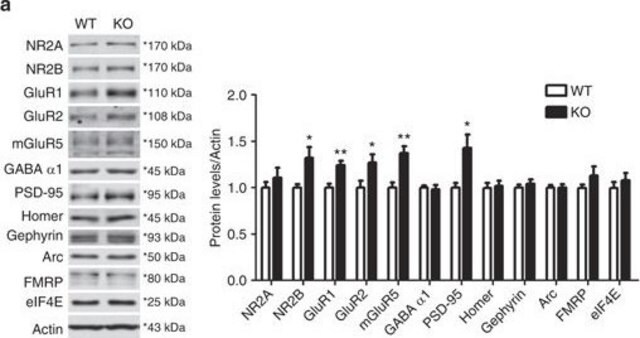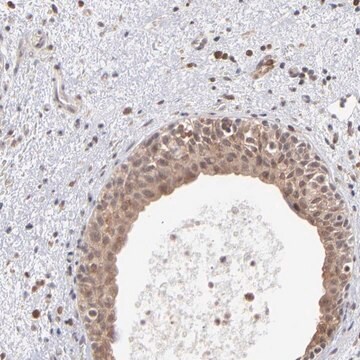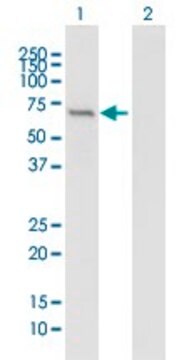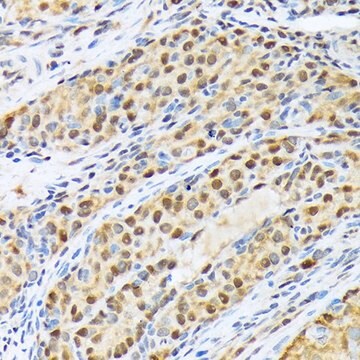ABF117
Anti-IFIT1/p56 Antibody
serum, from rabbit
Sinónimos:
Interferon-induced protein with tetratricopeptide repeats 1, IFIT-1, Glucocorticoid-attenuated response gene 16 protein, GARG-16, Interferon-induced 56 kDa protein, IFI-56K, P56
About This Item
Productos recomendados
origen biológico
rabbit
Nivel de calidad
forma del anticuerpo
serum
tipo de anticuerpo
primary antibodies
clon
polyclonal
reactividad de especies
human, mouse
técnicas
flow cytometry: suitable
immunocytochemistry: suitable
western blot: suitable
Nº de acceso NCBI
Nº de acceso UniProt
Condiciones de envío
wet ice
modificación del objetivo postraduccional
unmodified
Información sobre el gen
human ... IFIT1(3434)
Descripción general
Inmunógeno
Aplicación
Inflammation & Immunology
Inflammation & Autoimmune Mechanisms
Western Blotting Analysis: A representative lot from an independent laboratory detected IFIT-1/p56 in HT1080 cell lysates transfected with mouse p56 vector and not in HT1080 cell lysates transfected with empty vector (Terenzi, F., et al. (2007). J Virol. 81(16):8656-8665.).
Western Blotting Analysis: A representative lot from an independent laboratory detected IFIT-1/p56 in IFN-Beta treated wild type Stat1 MEF cell lysates and not in IFN-beta treated Stat1 knockdown MEF cell lsyates (Fensterl, V., et al. (2008). J Virol. 82(22):11045-11053.).
Western Blotting Analysis: A representative lot from an independent laboratory detected IFIT-1/p56 in IFN-Beta treated wild type p56 MEF cell lysates and not in IFN-Beta treated p56 knockdown MEF cell lysates (Fensterl, V., et al. (2012). PLoS Pathog. 8(5):e1002712.).
Immunocytochemistry Analysis: A representative lot from an independent laboratory detected IFIT-1/p56 in IFN-Beta treated MEF cell lysates (Terenzi, F., et al. (2007). J Virol. 81(16):8656-8665.).
Flow Cytometry Analysis: A representative lot from an independent laboratory detected IFIT-1/p56 in bone marrow cells and splenocyotes upon injection with dsRNA, IFN-alpha, and VSV (Terenzi, F., et al. (2007). J Virol. 81(16):8656-8665.).
Flow Cytometry Analysis: A representative lot from an independent laboratory detected IFIT-1/p56 in IFN-Beta treated CD3+ mature T cells, and in IFN-Beta treated myeloid Dendritic cells, but not in IFN-Beta treated plasmacytoid Dendritic cells (Fensterl, V., et al. (2008). J Virol. 82(22):11045-11053.).
Calidad
Western Blotting Analysis: A 1:1,000 dilution of this antibody detected IFIT1/p56 in 10 µg of mouse ovary tissue lysate.
Descripción de destino
Forma física
Almacenamiento y estabilidad
Handling Recommendations: Upon receipt and prior to removing the cap, centrifuge the vial and gently mix the solution. Aliquot into microcentrifuge tubes and store at -20°C. Avoid repeated freeze/thaw cycles, which may damage IgG and affect product performance.
Cláusula de descargo de responsabilidad
¿No encuentra el producto adecuado?
Pruebe nuestro Herramienta de selección de productos.
Código de clase de almacenamiento
10 - Combustible liquids
Clase de riesgo para el agua (WGK)
WGK 1
Certificados de análisis (COA)
Busque Certificados de análisis (COA) introduciendo el número de lote del producto. Los números de lote se encuentran en la etiqueta del producto después de las palabras «Lot» o «Batch»
¿Ya tiene este producto?
Encuentre la documentación para los productos que ha comprado recientemente en la Biblioteca de documentos.
Nuestro equipo de científicos tiene experiencia en todas las áreas de investigación: Ciencias de la vida, Ciencia de los materiales, Síntesis química, Cromatografía, Analítica y muchas otras.
Póngase en contacto con el Servicio técnico








